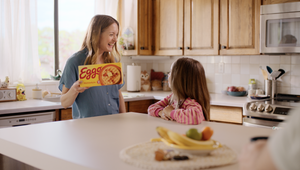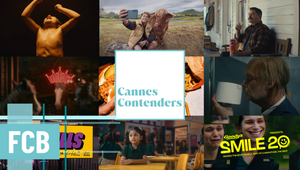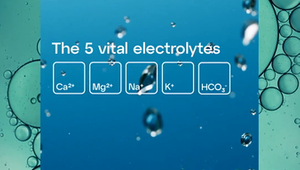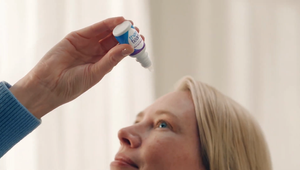
How FCB New York Is Building an Agency for the Future

FCB New York was recently named ‘Agency of the Year’ across four different industry shows: The One Show, ADC Awards, Clio Awards, and D&AD. And after witnessing the chemistry between the agency’s three leaders firsthand, it’s no surprise.
Sat around a table in a glass-walled office at their Park Avenue HQ, the trio of CEO Emma Armstrong, CCO Michael Aimette and CSO Todd Sussman are a portrait of familiarity. Happily discussing their remarkable five-year tenure as a leadership group, the relaxed conversation is interspersed with playful jibes and rallies of banter.
“We've had a lot of autonomy to run the agency how we think best. That includes the culture we've created, where everyone feels they not only belong here, but that the agency belongs to them,” says Emma, who also recently became FCB’s global transformation officer. “From running the agency to pitching, there’s a level of trust and unity across the team that I think is rare.”
The self-described “hive mind” leaders aren’t usually tucked away in a boardroom like this, instead sitting out on the main floor day-to-day to encourage different points of view. “Shared values and different perspectives is how you grow,” says Michael. “We have people who come up with crazy creative ideas and ways to run the business – because they feel like they can.
“There's no way I'm going to think less of someone if they come up with an idea that's so outlandish. In fact, if we stop that, we might as well quit now. We always have to keep beating our past work. So what's the next iteration of something? You have to think crazy and be beyond the pail, always.”
“There are no bad or good ideas; ideas are either on or off strategy,” adds Emma. “That’s with a small ‘s’ – business and creative strategy.” The flat structure and collaborative, transparent atmosphere prevents politicking and “makes those ideas that might seem crazy and strange doable,” she says.
“By staying together, we've built this culture, this agency of the future where we have the ability to test out new things. I love this industry and what agencies do at our best, so why not take the opportunity, using the great work we've consistently done for clients, to lead and change the industry, and make something new?”
Part of this process comes from introducing fresh talent and helping the next generation to share just as much as they learn. “New blood and new ways of thinking can unlearn bad behaviours,” says Michael, sharing that their weekly all-staff meeting ‘That Thursday Thing’ (TTT) has become a beacon of inspiration, advice and encouragement across departments and generations alike.
“There's a shared curiosity across the whole agency,” says Emma. “Everybody here has a voice in how we run this agency and shape the industry.
“Culture isn't a PowerPoint, it’s a behaviour that you create and reinforce every single day. So when you marry that culture with curiosity, you create an environment where everyone has something to learn and contribute, whether you're fresh out of Miami Ad School or you’ve been working in industry for 40 years.”
She continues, “We've had some good creative success over the last five years, and part of the reason is because they’re industry-changing and -leading ideas. They sit across many different categories because they're new ideas brought to life in a new way. That's a promise to the talent that comes here, and to our clients: We'll take care of you and your ideas.”
Two Huge Unlocks
To make more creative, effective work, earning them over 200 awards at the four aforementioned competitions in the last year, FCB New York has focused on “two huge unlocks”: brand experience (BX) and audience.
The former, Todd believes, has been underutilised for too long, relegated to presentation “cannon fodder” as ‘comms planning’. “We fundamentally disagree with that,” he says.
“[BX] is both an act of strategy and creativity. It's a layer that lives around everything that we do, and a way for us to ask how an idea expresses itself in the world. What are the right places? What's the right canvas for this to live on?”
Aligning with an industry-wide trend to bring media and creative closer together again, FCB New York’s BX approach “adds tension and another dimension” to the work, says Todd, by letting media input into the idea. “It becomes a synergistic system – one that used to work before we pulled it apart… That radically, fundamentally broke the industry in many ways.
“The vision for BX is that it becomes a fulcrum that brings all of it back together,” he adds. “Instead of, ‘we have a cool idea, where are you going to put it?’, the ‘where’ and the idea are all working together at the same time.”
In real terms, this means BX is positioned much further upstream at the agency, with the head of BX answering into the creative department – a dynamic mimicked by the production team also. “BX is part of the idea. Sometimes they are the idea,” says Michael. “That makes a huge difference in how we work; putting them all together and making them all feel like a part of the creative department. It’s a cliche but creative is an adjective, not a noun. And yes, ‘creative’ is a department, but it's also a state of mind and how we approach things. We have a very democratic point of view about what creative is.”
The second unlock comes from FCB New York 'fundamentally changing’ how it looks at audiences over the last four years.
Utilising IPG’s ethically sourced data set, Axiom, and other data aggregation tools, the agency now builds audiences that are not only based on behavioural psychology but which are fully attributable as well.
“We can find every single person in that growth audience, and it's addressable, so we can buy against it,” explains Emma. “As we started doing that, we really leant into BX. Because not having the ability to make sure our great work shows up in the right place to those people is a huge gap, in terms of effectiveness."
An Unrecognisable AI Industry?
AI is the other significant influence on FCB New York in 2025, and even as the leaders talk, the office beyond the glass walls is abuzz with people attending talks and presentations for one of the agency’s regular AI learning sessions.
“I don't think I'm going out on a limb by saying we are at a pivotal point,” says Todd, who believes the next year is a “breaking point” for advertising to change in three ways: ‘radically changing’ the process of creating ads, freeing up human creativity; shifting and merging roles and responsibilities, prompting leaders to rethink training and management; and a ‘dramatic change’ in the agency product offering itself.
“We're going to make solutions for the [client] organisation, not just in-market creativity,” he says. “[We’ll] create utility and use our creativity and ingenuity in new ways to add value… That's a radical transformation. And all of a sudden, that opens up whole new monetisation opportunities for an agency.”
He adds that this evolution might make the industry unrecognisable in five years, which is already causing tension between the accelerating capabilities of new AI tech and agencies’ ability to manage such a change.Though Emma is quick to reassure that compelling, emotional stories, shown in the right places, will remain essential.
“We are, ultimately, storytellers. How we do it will be wildly different but we still need human ingenuity, and that has been true for hundreds and hundreds of years, and will continue to be.”
A Creative Cure for Uncertainty
This discussion around the fragility of adland’s future, comes at a distinctly uncertain point in time for American agencies – “a very polarising period”, Michael describes of the socio-political and economic climates in the States.
“There's an uncertainty about what a week or three months from now looks like,” adds Todd. “That uncertainty is augmenting and enhancing what clients were already yearning for, which is assurance and confidence that the things we're putting out in the world for them are strategically and creatively on point… [They’re] hunkering down like, ‘We need to make sure this is right’.
“That's what I've seen a lot of clients looking for right now,” he continues. “And we have the tools, the partners, the research and the science to give them that reassurance. Once you have that, then you apply the creativity on top of it, which has the multiplier effect.”
Emma draws from the insecurity felt around the 2008 financial crisis, where many brands followed a “natural instinct” to derisk. “Our job is to push outside of the expected, so that you stand out and get the exponential benefit from what you do… Brands that stopped investing in 2008 have never caught up.”
She adds, “Obviously, the financial environment was very different, but a risky situation leads you to make safer choices. So if brands are pulling back, that will happen again, and they'll lose the opportunity to maintain their strategic leadership position.”
But whether it’s the uncertainty of an unrecognisable, AI future, or fears of economic instability in the US today, Emma is sure that FCB’s creativity remains at the forefront of their solutions – no matter what shape it eventually takes.
“Our goal, ultimately, is to continue to innovate and create the agency of the future for the benefit of our clients’ business goals, using creativity as that unlock. Our creativity is their economic multiplier. But how we do that is ongoing. That makes it fun! Who wants to do the same thing every day?”














